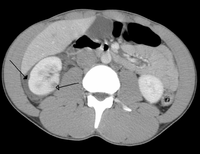
Photo from wikipedia
This multicenter retrospective cohort study from Japan found that children who sustained blunt liver and/or spleen injury of any grade has a potential risk of delayed pseudoaneurysm development and rupture… Click to show full abstract
This multicenter retrospective cohort study from Japan found that children who sustained blunt liver and/or spleen injury of any grade has a potential risk of delayed pseudoaneurysm development and rupture even after the early phase of interventional radiology. BACKGROUND Little guidance exists for the treatment of pseudoaneurysm (PA) following pediatric blunt liver and/or spleen injuries (BLSIs). We aimed to describe the incidence of delayed PA development and the subsequent clinical course of PA in pediatric BLSIs. METHODS This multicenter retrospective cohort study from Japan included pediatric patients (16 years and younger) who sustained BLSIs from 2008 to 2019. The cohort was divided into four groups based on hemostatic intervention within 48 hours of admission, namely, nonoperative management (NOM), NOM with interventional radiology (IR), operative management (OM), and combined IR/OM. Descriptive statistics were used to describe the incidence of delayed PA among the groups and to characterize the clinical course of any PAs. RESULTS A total of 1,407 children (median age, 9 years) from 83 institutions were included. The overall number (incidence) of cases of delayed PA formation was 80 (5.7%), and the number with delayed PA rupture was 16 cases (1.1%) in the entire cohort. Patients treated with NOM (1,056), NOM with IR (276), OM (53), and combined IR/OM (22) developed 43 (4.1%), 32 (12%), 2 (3.8%), and 3 (14%) delayed PAs, respectively. Among patients who developed any PAs, 39% of patients underwent prophylactic IR for unruptured PA, while 13% required emergency angioembolization for delayed PA rupture, with one ruptured case requiring total splenectomy. At least 45% of patients experienced spontaneous resolution of PA without any interventions. CONCLUSION Our results suggest that the risk of delayed PA still exists even after acute phase IR as an adjunct to NOM for BLSIs in children, indicating the necessity of a period of further observation. While endovascular interventions are usually successful for PA management, including rupture cases, given the high incidence of spontaneous resolution, the ideal management of PA remains to be investigated in future studies. LEVEL OF EVIDENCE Therapeutic/Care Management; Level IV.
Journal Title: Journal of Trauma and Acute Care Surgery
Year Published: 2022
Link to full text (if available)
Share on Social Media: Sign Up to like & get
recommendations!